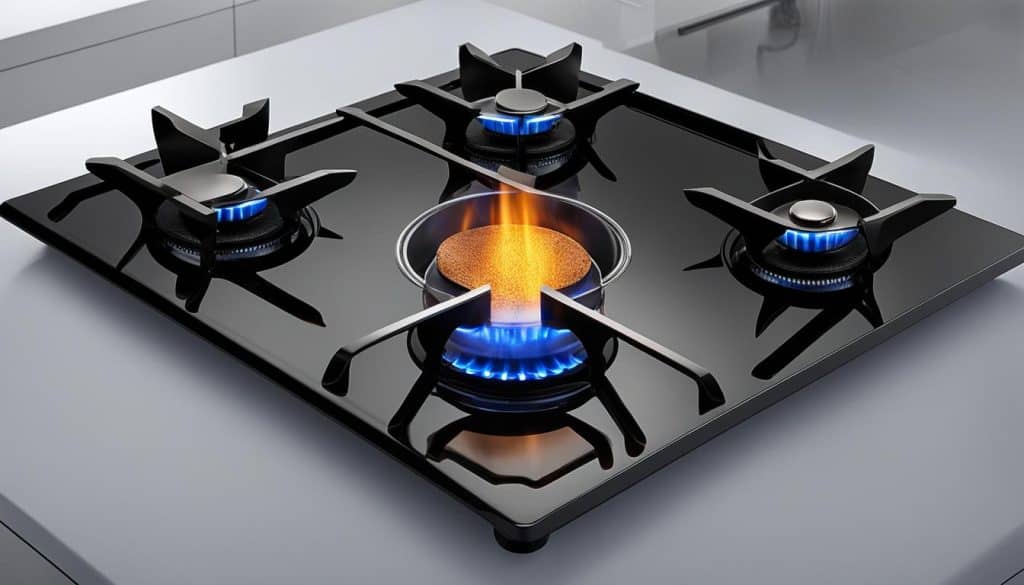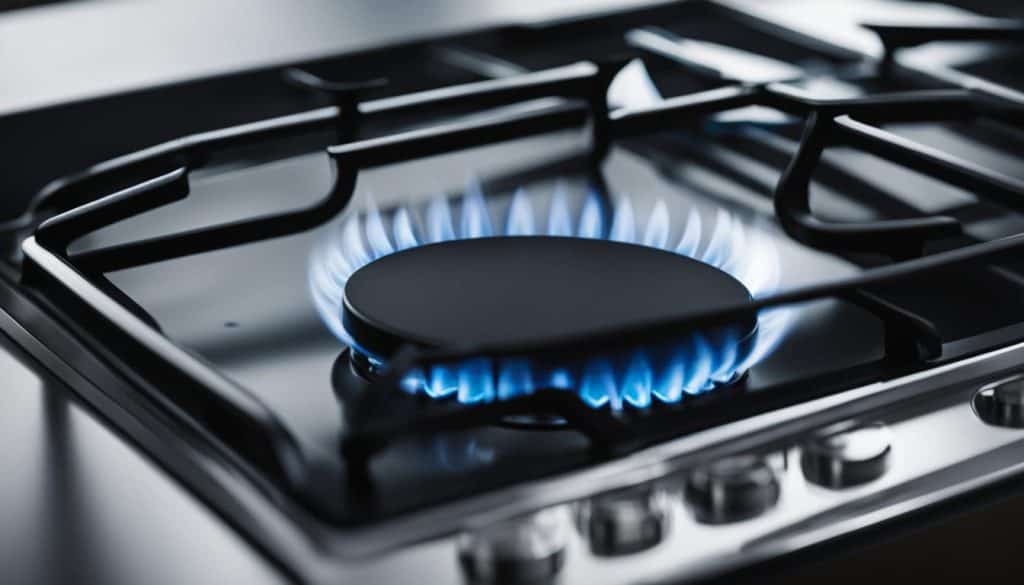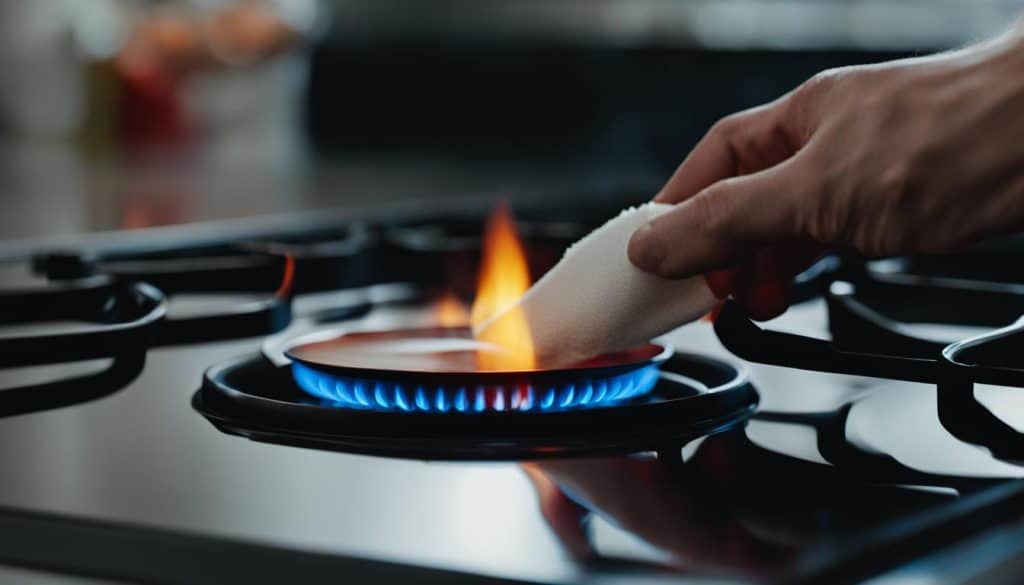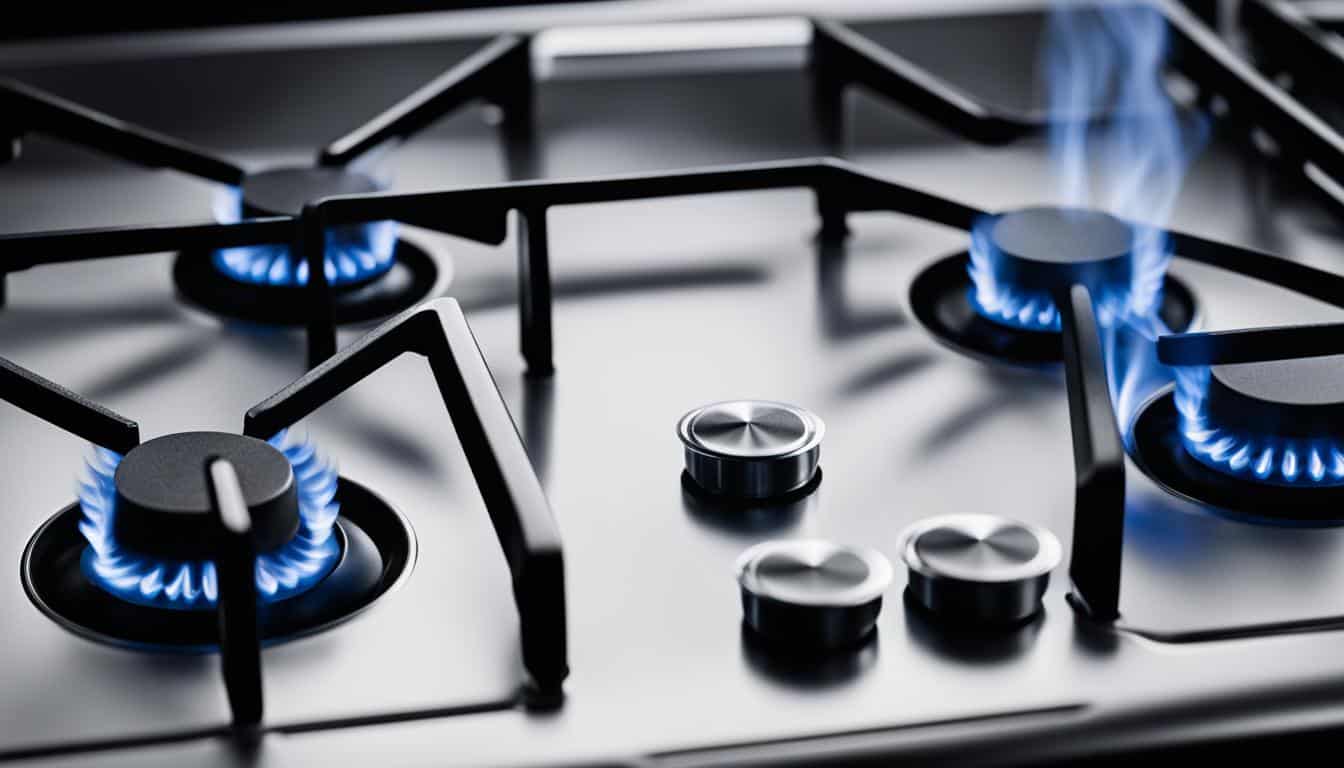Gas Cooktop Flame Failure Devices are crucial safety features in modern kitchens. These devices ensure that if the flame on your gas cooktop unexpectedly goes out, the gas supply is automatically cut off.
This prevents dangerous gas leakages, making them an essential component for anyone who values safety in the kitchen.
When we think about kitchen safety, gas cooktops often come to mind due to their potential risks. Flame Failure Devices significantly mitigate these risks.
A key component, the thermocouple, is a heat sensor that detects when the flame is extinguished and instantly activates the automatic shutoff mechanism. This feature not only enhances safety but also provides peace of mind, especially in households with children or pets.
The evolution of kitchen safety measures, like Flame Failure Devices in gas cooktops, reflects our growing awareness and concern for domestic safety. While cooking should be an enjoyable experience, ensuring the safety of our gas burners is paramount.
These devices seamlessly integrate with our daily cooking routines, offering an unseen yet powerful layer of protection against the dangers of gas leakage. As we continue to prioritize safety in our homes, these innovations become not just additions, but necessities in every kitchen.
What is a Gas Cooktop Flame Failure Device?
If you’re not familiar with gas cooktop flame failure devices, don’t worry – they’re simple to understand. In simple terms, a gas cooktop flame failure device is a safety feature that automatically shuts off the gas supply to the cooktop if the flame goes out.
This may not seem like a big deal, but it’s actually a crucial safety feature, especially in households with children. Without a flame failure device, gas can continue to flow even if the flame is out, leading to potential hazards like gas leaks, fires, and explosions.
The gas cooktop flame failure device serves a simple yet vital function in ensuring the safety of your household while cooking. It’s a small investment that can provide significant peace of mind.
“Without a flame failure device, gas can continue to flow even if the flame is out, leading to potential hazards like gas leaks, fires, and explosions.”
How Does a Gas Cooktop Flame Failure Device Work?
If you’re unfamiliar with gas cooktop flame failure devices, you might be wondering how they work. Let’s take a closer look at the components and operation of these devices.
The Components
Gas cooktop flame failure devices consist of a thermocouple or thermistor, a gas valve, and a control module.
A thermocouple is a sensor that measures temperature and generates electrical voltage. When a flame is present, the thermocouple generates a small electrical signal that keeps the gas valve open and allows gas to flow to the burner.
When the flame goes out, the thermocouple stops generating the electrical signal, and the gas valve closes to prevent gas from leaking into the kitchen.
A thermistor works in a similar way to a thermocouple. It senses temperature changes and sends a signal to the control module to open or close the gas valve. However, it uses electrical resistance rather than voltage to do so.
The Operation
The operation of a gas cooktop flame failure device is quite simple. When you turn on the burner, gas flows t ough the gas valve and ignites at the burner.
The flame heats up the thermocouple or thermistor, which generates the electrical signal that keeps the gas flowing. As long as the flame is present, the gas valve remains open and the burner continues to function normally.
If the flame goes out due to a gust of wind, a spill, or any other reason, the thermocouple or thermistor stops generating the electrical signal.
The control module interprets this signal as a fault and sends a message to the gas valve to close. The gas flow to the burner is immediately shut off, preventing gas leaks and potential hazards.
Common Misconceptions and Questions
“Can gas cooktop flame failure devices be installed on any type of gas cooktop?”
“Do I need to replace the thermocouple or thermistor regularly?”
Gas cooktop flame failure devices are designed to work with most gas cooktops. However, they may require some modifications or special installation techniques depending on the model. It’s always best to consult the manufacturer’s instructions before attempting to install one of these devices.
As for replacing the thermocouple or thermistor, it’s not necessary as long as the device is working properly. However, if you notice any signs of wear and tear or a malfunctioning device, you may need to replace the component to ensure optimal function and safety.
Overall, gas cooktop flame failure devices are simple yet effective safety features that can provide peace of mind and enhance your cooking experience.

Different Types of Gas Cooktop Flame Failure Devices
Gas cooktop flame failure devices come in various types, each with their own mechanisms to detect when a flame goes out. The two most common types are thermocouples and thermistors.
Thermocouples: These devices are made up of two different metals joined together at one end. When a flame is present, it heats up the metals, and this generates a small electrical current that keeps the gas valve open.
When the flame goes out, the electrical current stops, and the gas valve closes, thereby preventing gas leakage. Thermocouples are robust and long-lasting, making them a popular choice for many gas cooktops.
Thermistors: These devices use the change in temperature to detect when a flame goes out. They are made up of two different materials, one that conducts electricity and another that doesn’t.
When a flame is present, the material that conducts electricity heats up, and its resistance to electrical current decreases. This change in resistance is detected by a control board that keeps the gas valve open.
If the flame goes out, the temperature drops, and the resistance increases. The control board then shuts off the gas valve, preventing gas leakage. Thermistors are more sensitive to temperature changes and are less expensive than thermocouples.
It’s important to note that gas cooktops can have both thermocouples and thermistors to enhance safety. For example, some cooktops have a thermocouple on the main burner and a thermistor on the smaller burners, depending on the manufacturer’s design.
Preventing Gas Leaks with Gas Cooktop Flame Failure Devices
Gas leaks can be a serious safety hazard in the kitchen. However, with gas cooktop flame failure devices, you can significantly reduce the risk of gas leaks and ensure a safe cooking environment.
These devices are designed to automatically shut off the gas supply if the flame goes out, preventing any gas leaks.
The gas cooktop flame failure device works by using a thermocouple or a thermistor to detect the heat from the flame. The component sends a signal to the gas valve to keep the gas flowing, but if the heat stops, the signal stops and the gas valve closes, preventing gas from escaping.

However, it’s important to note that a gas cooktop flame failure device is not foolproof. It’s still crucial to keep your gas cooktop clean and well-maintained to prevent any leaks or malfunctions.
You should also have an experienced technician inspect your cooktop regularly to ensure it’s functioning properly.
By using gas cooktop flame failure devices, you can enjoy the benefits of cooking with gas while also ensuring your safety and peace of mind.
Protecting Against Hazards with Gas Cooktop Flame Failure Devices
Gas cooktops are a convenient and essential tool for cooking, but they also come with considerable hazards. Accidental fires and explosions can occur, posing a serious risk to your safety and that of your family.
This is where gas cooktop flame failure devices come in handy. They help prevent dangerous gas leaks and protect against potential hazards, making your cooking experience safer and more secure.

Without a flame failure device, a gas cooktop can continue to discharge gas even if the flame blows out.
A small spark can trigger an explosion, which is why it’s important to have a device that can detect when the flame goes out and quickly shut off the gas supply to prevent a potential disaster.
Flame Failure Devices vs. Thermocouples
Gas cooktops come with two different types of flame failure devices, a thermocouple system, and a thermistor system. The thermocouple system is the more traditional option, consisting of a metal rod that generates an electrical current when heated by a flame.
If the flame goes out, the electrical current stops, and the gas supply to the cooktop is automatically shut off. Thermistors, on the other hand, are more advanced, using an electronic sensor to detect when the flame is extinguished and then shutting off the gas supply.
Both systems are effective at preventing gas leaks and protecting against hazards, but thermistors are generally considered more reliable and accurate.
Preventing Accidental Fires and Explosions
A flame failure device is a crucial safety feature that can prevent accidental fires and explosions in your kitchen. In case the gas accidentally escapes and gets ignited due to some other heat source, gas cooktop flame failure devices ensure that there is no additional gas supply, thereby preventing an explosion.
Gas cooktops are also prone to grease fires, which can quickly spread to other areas of your kitchen. A flame failure device will shut off the gas supply, preventing the fire from spreading and reducing the risk of serious injury or property damage.
Peace of Mind with Gas Cooktop Flame Failure Devices
If you’re a parent or have young children in your household, you understand the importance of keeping your family safe. This includes ensuring the safety of your kitchen, where many potential hazards lurk. Gas cooktops pose a particular risk, with the possibility of gas leaks, fires, and explosions.
Fortunately, gas cooktop flame failure devices can provide you with the peace of mind you need while cooking. By automatically shutting off the gas supply if the flame goes out unexpectedly, these devices prevent gas leaks and reduce the risk of fires or explosions.
For families with young children, this added level of safety is invaluable. Children are naturally curious and may inadvertently turn the gas knob or touch a hot burner. With a gas cooktop flame failure device, you can be confident that your children are protected from potential accidents.
Knowing that your gas cooktop is equipped with a flame failure device can alleviate anxieties and allow you to focus on cooking, rather than worrying about potential hazards.

Investing in a gas cooktop flame failure device is a simple step you can take to ensure the safety of your family and home. With this device, you can cook with ease and peace of mind, knowing that you’re taking the necessary precautions to prevent accidents and protect your loved ones.
Maintaining Your Gas Cooktop Flame Failure Device
Regular cleaning and maintenance of your gas cooktop flame failure device are crucial to ensure optimal performance. Here are some tips to help you keep your device in top shape:
- Clean your device after every use: Use a soft, damp cloth or sponge to wipe down the device’s surface. Avoid using abrasive cleaners or steel wool, as they can damage the device.
- Remove grates and caps: Take off the grates and caps and clean them with soap and water. If they are dishwasher safe, place them in the dishwasher for easy cleaning.
- Clean the burners: Use a toothbrush or a paper clip to remove any debris or food particles from the burners. Wipe them down with a damp cloth afterwards.
- Check the ignition: Make sure that the ignition is producing a spark and that the flame comes on quickly and evenly.
- Consult the manufacturer’s manual: The manual will provide you with specific instructions on how to clean and maintain your device. Follow them carefully to avoid damaging the device or voiding your warranty.
If you experience any issues with your gas cooktop flame failure device, here are some troubleshooting tips:
- Check the gas supply: Ensure that your gas supply is turned on and that there are no leaks present.
- Replace faulty components: If a component, such as the igniter, is faulty, replace it as soon as possible to ensure optimal performance.
- Seek professional help: If you’re unsure about how to troubleshoot a problem, contact a professional technician to help you diagnose and fix the issue.
By following these tips, you can ensure that your gas cooktop flame failure device remains in optimal condition, providing you with long-lasting performance and peace of mind while cooking.

Gas Cooktop Safety and Kitchen Safety Tips
When it comes to gas cooktop safety, there are a few things you can do to ensure a safe and healthy kitchen environment. Read on for some simple kitchen safety tips that can help prevent gas leaks and fires, protect your home and loved ones, and keep your gas appliances running smoothly.
Check your Gas Cooktop Regularly
One of the most important things you can do to ensure gas cooktop safety is to check your cooktop regularly. Inspect all the burners and valves for signs of wear and tear, damage, or leaks. If you suspect a gas leak, turn off the gas, open all your windows, and call a professional to fix the problem immediately.
Clean Your Cooktop Frequently
Another way to prevent gas leaks and fires is to clean your cooktop frequently. Grease, oil, and food can build up on your cooktop and create a fire hazard. Use a soft cloth or sponge to clean the cooktop after each use, and avoid using abrasive or corrosive cleaners that can damage the surface.
Install Smoke Detectors and Carbon Monoxide Alarms
Smoke detectors and carbon monoxide alarms can help protect your home and loved ones from gas leaks, fires, and other hazards. Make sure to install smoke detectors outside each sleeping area and on every level of your home, and test them regularly to make sure they are working properly.
Practice Safe Cooking Habits
Practicing safe cooking habits can also help prevent gas leaks and fires. Always use your cooktop in a well-ventilated area, never leave it unattended while cooking, and keep flammable objects away from the burners. Additionally, make sure to teach your children about gas cooktop safety and the importance of using gas appliances properly.
Understand the Role of Thermistors
Finally, it’s important to understand the role of thermistors in gas cooktop safety. A thermistor is a sensor that measures temperature and can help prevent gas leaks and fires by shutting off the gas supply if the temperature gets too high. Make sure your cooktop has a thermistor installed and test it regularly to ensure it is functioning properly.
Implementing these gas cooktop safety and kitchen safety tips will help protect your home and loved ones, and ensure that you are using your gas appliances properly. Remember to check your cooktop regularly, clean it frequently, install smoke detectors and carbon monoxide alarms, practice safe cooking habits, and understand the role of thermistors in enhancing gas cooktop safety.


